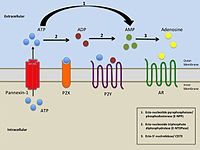
Photo from wikipedia
Cerebral ischemic injury is a leading cause of human mortality and disability, seriously threatening human health in the world. Activin A (Act A), as a well-known neuroprotective factor, could alleviate… Click to show full abstract
Cerebral ischemic injury is a leading cause of human mortality and disability, seriously threatening human health in the world. Activin A (Act A), as a well-known neuroprotective factor, could alleviate ischemic brain injury mainly through Act A/Smads signaling. In our previous study, a noncanonical Act A/Smads signal loop with self-amplifying property was found, which strengthened the neuroprotective effect of Act A. However, this neuroprotective effect was limited due to the self-limiting behavior mediated by Smad anchor for receptor activation (SARA) protein. It was reported that microRNA-17-5p (miR-17-5p) could suppress the expression of SARA in esophageal squamous cell carcinoma. Thus we proposed that knockdown of miR-17-5p could strengthen the neuroprotective effect of Act A/Smads signal loop through SARA. To testify this hypothesis, oxygen–glucose deficiency (OGD) was introduced to highly differentiated rattus pheochromocytoma (PC12) cells. After the transfection of miR-17-5p mimic or inhibitor, the activity of Act A signal loop was quantified by the expression of phosphorylated Smad3. The results showed that suppression of miR-17-5p up-regulated the expression of SARA protein, which prolonged and strengthened the activity of Act A signaling through increased phosphorylation of downstream Smad3 and accumulation of Act A ligand. Further luciferase assay confirmed that SARA was a direct target gene of miR-17-5p. These practical discoveries will bring new insight on the endogenous neuroprotective effects of Act A signal loop by interfering a novel target: miR-17-5p.
Journal Title: Neurochemical Research
Year Published: 2019
Link to full text (if available)
Share on Social Media: Sign Up to like & get
recommendations!